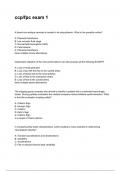ccp/fpc exam 1
A three-hour-antique neonate is located to be polycythemic. What is the possibly motive?
A: Placental transfusion
B: Low amniotic fluid stage
C: Normal fetal hemoglobin (HbF)
D: Fetal anemia
A: Placental transfusion
three multiple choice alternatives
Inadvertant migration of the intra-aortic balloon can also purpose all the following EXCEPT:
A: Loss of renal perfusion
B: Loss of go with the flow to the carotid artery
C: Loss of blood waft to the renal arteries
D: Loss of flow to the subclavian artery
B: Loss of flow to the carotid artery
three multiple desire alternatives
The shipping group company has arrived to transfer a patient with a confirmed hemorrhagic
stroke. During pupillary evaluation the medical company notices bilateral eyelid retraction. What
is that this evaluation locating called?
A: Collier's Sign
B: Kernig's Sign
C: Cullen's
D: Kehr's Sign
A: Collier's Sign
3 a couple of choice options
In comparing fetal heart characteristics, which locating is most essential in determining
neurological maturity?
A: Transient accelerations and decelerations
B: Variability
C: Accelerations
D: Flat or reduced beat-to-beat variability
,B: Variability
three multiple desire options
Which of the following hemodynamic parameters might suggest left ventricular failure in a
patient with chronic obstructive pulmonary sickness (COPD)?
A: PAP forty eight/26, PCWP 20
B: PAP 25/21, PCWP 13
C: PAP forty eight/26, PCWP 12
D: PAP 22/12, PCWP 16
A: PAP forty eight/26, PCWP 20
3 more than one desire alternatives
Which of the following hemodynamic parameters could be most indicative of cardiogenic
surprise?
A: Systolic blood stress 140 mmHg, CI 3 L/min, PCWP 8 mmHg
B: Systolic blood stress 80 mmHg, CI 1.Eight L/min, PCWP 30 mmHg
C: Systolic blood strain ninety mmHg, CI 2.2 L/min, PCWP five mmHg
D: Systolic blood stress one hundred twenty mmHg, CI 4 L/min, PCWP 12 mmHg
B: Systolic blood strain 80 mmHg, CI 1.8 L/min, PCWP 30 mmHg
3 a couple of choice options
The primary treatment in reversing malignant hyperthermia is what remedy?
A: Dantrolene
B: Calcium chloride
C: Vecuronium
D: Fentanyl
A: Dantrolene
3 multiple choice alternatives
provide an explanation for the image
A forty-year-old male patient with a history of a worrying mind injury is being transported through
helicopter to a nearby facility. During the flight, you review the scientific records and observe
that the affected person supplied to the emergency department that morning with low serum
osmolality, hyponatremia, and a excessive urine unique gravity. You suspect this affected
person can be laid low with:
,A: Anaphylaxis
B: Diabetes insipidus (DI)
C: Syndrome of inappropriate anti-diuretic hormone (SIADH)
D: Traumatic brain harm (TBI)
C: Syndrome of irrelevant anti-diuretic hormone (SIADH)
3 more than one desire options
A patient offers in thyroid storm from an exacerbation of hyperthyroidism. What are their
predicted labs?
A: TSH multiplied, T3 and T4 decreased
B: TSH multiplied, T3 and T4 expanded
C: TSH depressed, T3 and T4 reduced
D: TSH depressed, T3 and T4 accelerated
D: TSH depressed, T3 and T4 extended
three a couple of preference options
Regarding the diabetic ketoacidosis PT, Glucose must be reduced based on the subsequent
guidlines?
A: Glucose reduced < 200mg/dL according to hour
B: Glucose decrease < 100mg/dL per hour
C: Glucose decrease > 200mg/dL consistent with hour
D: Glucose lower > 100mg/dL according to hour
B: Glucose lower < 100mg/dL per hour
3 multiple choice options
You respond to a local ER to transport a 50 year old female. You receive lab values after leaving
the facility and note a Na: 160 alond with a inceares oslolality serum, urinary output, and a low
specific gravity. What is more than likely occuring?
A: Thyroid storm
B: Diabetes Insipidus (DI)
C: Sepsis shock
D: Sickle-Cell Crisis
B: Diabetes Insipidus (DI)
, 3 multiple choice options
A patient was recently started on enteral feedings at a long-term care facility. They are
transferred to the local emergency room due to a change in their level of consciousness.
Current lab values are: Na+ 150, BUN 80 mg/dL, serum glucose 870 mg/dL, and serum
osmolality 377 mOsm/kg. What is the most likely cause of the abnormal serum osmolality?
A: Syndrome of inappropriate antidiuretic hormone
B: Overuse of diuretics
C: Overhydration
D: Dehydration
A patient with a history of seizure activity just before arrival is being transported. The patient has
been outside fishing in mid-July. Labs are as follows: CK 28,000, BUN 68, Cr 2.0, and urine is
very dark with urine output from a Foley catheter of 20 mL over the past 2 hours. The patient is
unresponsive with the following vital signs: BP 100/40, HR 140, RR 28, SpO2 94%. What is the
suspected diagnosis?
A: Tricyclic antidepressant overdose
B: Urosepsis
C: Rhabdomyolysis
D: Acute coronary syndrome
A post-traumatic injury patient has received six units of packed red blood cells. The patient's
2,3-DPG is anticipated to change and has what effect on the oxyhemoglobin dissociation curve?
A: Shift to the left, increasing hemoglobin's affinity for oxygen
B: Shift upward, thus increasing the patient's oxygenation status
C: Shift to the right, decreasing hemoglobin's affinity for oxygen
D: No change as 2,3-DPG does not affect the oxyhemoglobin dissociation curve
A: Shift to the left, increasing hemoglobin's affinity for oxygen
3 multiple choice options
Fractures of the 1st-3rd ribs should indicate a high index of suspicion for which injury?
A: Pulmonary contusion
B: Aortic dissection
C: Esophageal rupture
D: Liver laceration
B: Aortic dissection




